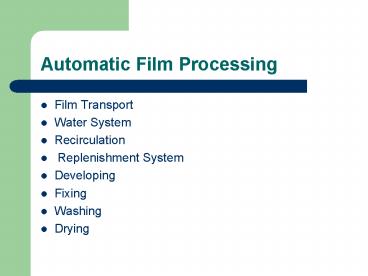Automatic Film Processing - PowerPoint PPT Presentation
1 / 31
Title:
Automatic Film Processing
Description:
Preservatives of the Developer. Sodium or potassium sulfite ... Preservative of the fixer. Sodium sulfite. Prevents decomposition of the fixer ... – PowerPoint PPT presentation
Number of Views:3098
Avg rating:3.0/5.0
Title: Automatic Film Processing
1
Automatic Film Processing
- Film Transport
- Water System
- Recirculation
- Replenishment System
- Developing
- Fixing
- Washing
- Drying
2
Film Transport
- A system of rollers that moves the film through
the developer, fixer, washing and drying sections
of the processor. - Also acts as a squeegee action to remove excess
chemicals from the film.
3
Make up of the Transport System
- Entrance roller or detector roller
- Vertical or Deep racks (transport racks)
- Crossover assembly
- Squeegee assembly
4
Entrance roller or detector roller
- Contains the Entrance rollers and guide shoes
which moves film into the developer tank - Also contains a micro switch which turn on the
replenishment pump
5
Vertical or Deep racks (transport racks)
- Moves film into and through solutions and dryer
- Uses a turn around assembly at the bottom of the
tank to turn film direction upward.
6
Crossover assembly
- Moves film form developer to fixer tank and from
the fixer to the wash tank - Forces solutions from film back into the tank it
is coming from.
7
Squeegee assembly
- Moves the film from the wash tank to the dryer
- Squeegee action removes excess water from the
film.
8
Water System
- Washing the film
- Temperature control
9
Circulation or Recirculation or Filtration System
- Agitates developer solution
- Removes reaction particles by the use of a
filtration system - Helps stabilize developer temperature.
- Agitation and circulation
- Agitation keeps solutions in contact with a
heater element in the bottom of the tank and
prevents layering of chemicals - Maintains developer temperature
- Heating element is controlled by a thermostat
10
Replenishment or Regeneration Systems
- Responsible for replenishing processor solutions
that are used during processing - Consist of a series of umps, plastic tubing and
plastic storage tanks. - Replenishment is based on the length of the film
processed.
11
Types of Replenishment
- Volume Replenishment
- A volume of chemicals are replaced for each film
that is processed. - Flood Replenishment
- Periodically replenishes chemicals regardless of
the number of films processed.
12
Developing
- Changing the latent image of film to a visible
image (manifest image) composed of minute
clusters of silver.
13
Components of the Developer
- Solvents
- Developing agents
- Accelerators
- Preservatives
- Restrainers
- Hardeners
14
Solvents of the Developer
- Water is the solvent in the developer
- Water dissolves and ionizes the developer
chemicals - Film emulsion also absorbs water, causing it to
swell. This allows the dissolved developing
agents to penetrate the emulsion and to reach all
the silver halide crystals.
15
Developing or Reducing Agents
- This component oxidizes the silver and converts
the latent image into the manifest image - Two Components of Reducing Agents
- Hydroquinone - Slowly builds black tones for
contrast - Phenidone quickly builds gray tones
16
Accelerators or Activator
- Composed of
- Sodium or potassium carbonate
- Sodium or potassium hydroxide
- Increase the rate of chemical reaction,
converting exposed silver halide grains into
metallic silver at a more rapid rate. - Swells and softens the emulsion so that the
reducing agents may work more effectively. - Provides an alkaline medium for reducing agents
17
Accelerators or Activator
- Must have a pH of between 10 and 11.5
- Must be alkaline
18
Preservatives of the Developer
- Sodium or potassium sulfite
- Help maintain the rate of development and prevent
staining of the film emulsion layer - Also helps protect the hydroquinone from oxidation
19
Restrainers or anti-foggers
- Potassium bromide
- Potassium iodide
- Protect unexposed silver halide grains from the
action of the developer, minimizing film fog.
20
Hardeners of Developer
- Glutaraldehyde
- Prevents excessive swelling of the gelatin and
damage to the film as it passes through the
rollers.
21
Fixing
- Clearing of undeveloped crystals before washing
to prevent discoloration of the film with age or
exposure to visible light.
22
Fixer Components
- Solvent
- Fixing agent
- Preservative
- Hardener
- Acidifier
- Buffer
23
Solvent of the Fixer
- Water
- Diffuses into the emulsion, carrying with it the
other dissolved chemicals of the fixer.
24
Fixing or Clearing Agent
- Sodium thiosulfate and ammonium thiosulfate
- Dissolves and removes the undeveloped silver
halide grains from the emulsion. - This allows the unexposed areas of the film to go
from a milky-white appearance to a transparent
appearance.
25
Preservative of the fixer
- Sodium sulfite
- Prevents decomposition of the fixer
- Makes the fixer able to recycle back into a fixer
solution
26
Hardener or Tanning Agent of the Fixer
- Aluminum chloride, aluminum sulfide, or potassium
alum. - Prevents the gelatin of the emulsion from
swelling excessively. - Also prevents softening by the wash water or by
warm air drying. - Shortens the drying time.
27
Acidifier
- Acetic acid
- Accelerates the action of other chemicals
- Neutralize any developer that may be carried over
from the developer tank.
28
Buffer
- Chemical compounds that maintain a constant pH of
the solution during the fixing process. - Maintain pH of Fixer
- Should be between 4 and 4.5
29
Washing
- Removes the last traces of processing chemicals
and prevents fading or discoloration.
30
Drying
- To dry the radiograph after being processed.
- A blower supplies heated air to the dryer section
of the film processor which consist of tube like
rollers. Most of the air is recirculated. The
rest is vented to prevent buildup of excessive
humidity in the dryer.
31
THE END































